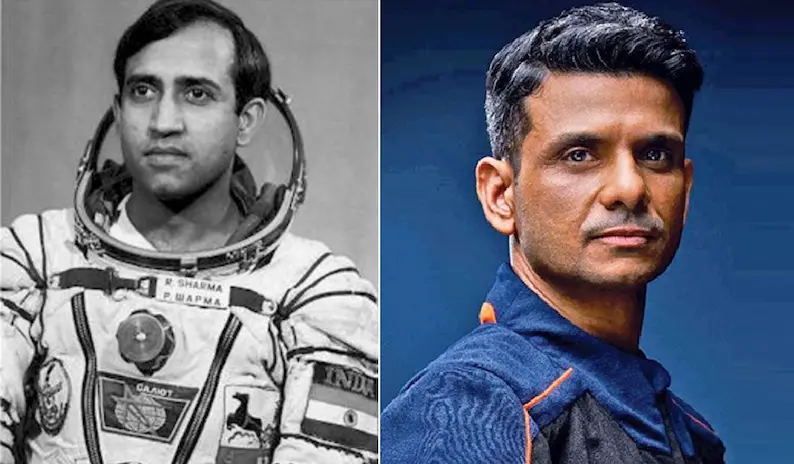
Four decades after Rakesh Sharma’s historic spaceflight, IAF’s Shubhanshu Shukla has reignited India’s human space legacy aboard Axiom Mission 4.
From Soyuz to SpaceX: A Legacy Takes Flight Again
On April 3, 1984, Wing Commander Rakesh Sharma etched his name into history as the first Indian in space. Aboard the Soviet Soyuz T-11, he spent nearly eight days aboard the Salyut 7 space station, conducting biomedical and remote sensing experiments. His poetic reply to Prime Minister Indira Gandhi, “Saare Jahan Se Achha” became a national anthem of pride and aspiration.
Yet, after that singular feat, India’s human spaceflight ambitions entered a long dormancy. While ISRO soared with missions like Chandrayaan, Mangalyaan, and record-breaking satellite launches, the dream of sending another Indian into space remained unfulfilled.
That changed on June 25, 2025, when Group Captain Shubhanshu Shukla of the Indian Air Force launched aboard Axiom Mission 4, becoming the second Indian in space and the first to reach the International Space Station (ISS). His journey aboard SpaceX’s Crew Dragon spacecraft marked not just a personal milestone, but a national resurgence in human space exploration.
The Making of a Modern Astronaut
Born in Lucknow in 1985, Shubhanshu Shukla’s path to the stars was forged through discipline, service, and scientific rigor. Commissioned into the IAF in 2006, he logged over 2,000 flight hours on aircraft like the Su-30 MKI, MiG-29, and Jaguar. In 2019, he was selected for India’s Gaganyaan program and underwent intensive training in Russia and India.
His inclusion in Axiom-4 was announced in February 2024 by Prime Minister Narendra Modi, alongside three other astronauts shortlisted for Gaganyaan. Shukla’s role as mission pilot on Axiom-4 placed him at the heart of a four-member international crew led by veteran astronaut Peggy Whitson, with specialists from Poland and Hungary.
Unlike Sharma’s government-to-government mission, Shukla’s flight was a commercial collaboration involving NASA, SpaceX, ISRO, and Axiom Space. It reflects India’s growing integration into the global space ecosystem and its readiness to lead in scientific innovation.
Science, Symbolism, and the Road Ahead
Axiom-4 is not just a symbolic return, it’s a scientific powerhouse. Shukla is conducting seven Indian-designed experiments, including:
- Space farming with moong and methi seeds
- Microbial behavior in microgravity
- Muscle cell regeneration
- Tardigrade resilience studies
These experiments aim to advance sustainable life-support systems, regenerative medicine, and space biology, critical for future Moon and Mars missions.
Shukla’s mission also carries deep emotional weight. Before liftoff, he said, “Even if this story, my story, is able to change one life, it would be a huge success for me”. His words echo Sharma’s legacy, not just as a spacefarer, but as an inspiration to generations.
India’s space roadmap now includes the Gaganyaan mission by 2027, a Bharatiya Antariksh Station by 2035, and a crewed Moon landing by 2040. Shukla’s flight is the bridge between past glory and future ambition.
Conclusion:
From Rakesh Sharma’s poetic patriotism to Shubhanshu Shukla’s scientific precision, India’s human spaceflight journey has come full circle. Legacy Reignited is not just a title, it’s a testament to a nation that dares to dream again. As the tricolor floats once more in orbit, it carries with it the hopes of a billion hearts and the promise of a stellar future.
Stay updated with the latest news on Rapido Updates. Keep yourself updated with The World, India News, Entertainment, Market, Automobile, Gadgets, Sports, and many more